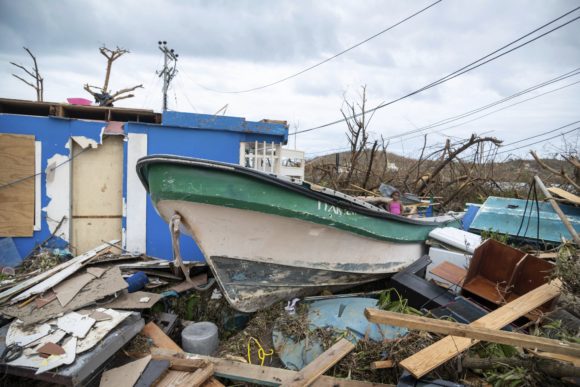HAVANA/GUATEMALA CITY — Villagers in Guatemala’s Mayan hillside hamlet Sanimtaca had been about to harvest their cardamom crops that take three years to grow when waves of floodwater triggered by two tropical storms last month washed them away.
Now they have no way to support themselves or to build back the 25 homes – a third of the village – also destroyed in the flash floods that have yet to subside, said Raul Quib, a volunteer from a neighboring community.
“No one had ever seen flooding like it around here,” the 35-year-old who has been collecting food and clothing donations told Reuters. “The school isflooded, the cemetery is flooded.”
This week brought an official close to the most active Atlantic hurricane season ever recorded, with 30 named storms including 13 hurricanes.
And thanks to climate change, experts warn, Central America will have to brace for stronger storm impacts in the future – as well as higher economic damages, unless they prepare.
The region, which already has some of the highest poverty rates in Latin America, was particularly hard hit by hurricanes this year.
Two of the year’s strongest storms, Eta and Iota, ravaged swathes of Panama, Costa Rica, Honduras, Nicaragua, El Salvador, Guatemala and Belize in unusually quick succession in November.
Altogether, more than 200 people were killed and more than half a million displaced. Hundreds of thousands are now unsure where their next meals will come from.
In Sanimtaca, villagers were able to flee to higher ground in time to escape the flooding. But elsewhere in the mountainous central Guatemalan region of Alta Verapaz, storm-triggered landslides buried dozens of houses with people inside.
Hurricane Eta alone caused up to $5.5 billion in damage in Central America, the Inter-American Development Bank said, while the impact of Iota has not yet been determined.
So far, only Nicaragua has provided official estimates of damage of both storms, putting it at more than $740 million, around 6.2% of gross domestic product.
“If we don’t manage to contain global warming to 2 degrees Celsius, we can expect an intensification of such natural disasters in the region with increasing costs,” said Luis Miguel Galindo, climate change expert and economics professor at Mexico’s UNAM university.
Currently, the world is on track to surpass 2°C of warming above pre-industrial temperatures.
If temperatures rise 2.5 °C by mid-century, the main costs of climate change could tally 1.5% to 5% of the annual GDP of Latin America and the Caribbean, according to a 2017 United Nations report that Galindo co-authored. It put the cost of adapting below 0.5% of GDP.
Slower Storms, Longer Season
Climate change overall is changing how hurricanes behave, scientists say, by warming up the ocean water through which they draw their power. Winds are blowing stronger. Storms are dropping heavier rains.
“We have more energy embedded in the oceans, and 90% from climate change,” said Belizean meteorologist Carlos Fuller, the lead climate change negotiator for the Alliance of Small Island States.
And hurricanes are sometimes moving more slowly, stalling for longer on land or traveling farther before breaking up, recent research has shown.
That can mean even more rainfall, wind and destruction for communities in a storm’s path. In 2017, Hurricane Harvey turned Houston’s highways into tidal rivers after stalling for four days near or over the Texas coast. Scientists say Eta and Sally behaved this way, too, hence the unusual flooding in Sanimtaca.
“The evidence is building that there is a human fingerprint on this behavior,” said Jim Kossin, climate scientist with the National Oceanic and Atmospheric Administration (NOAA). In a study published in June 2018 in the journal Nature, Kossin found that hurricane speeds had decreased worldwide by about 10% between 1949 and 2016.
This year’s storm count included six major hurricanes, twice the long-term average, said meteorologist Philip Klotzbach, who researches hurricanes at Colorado State University.
The year also saw nine storms that rapidly intensified, he said. Iota for example spun from a 70 mile-per-hour (113 km-per-hour) tropical storm to a 160-mph (257-kph) Category 5 hurricane in 36 hours. The only other years that saw so many such storms were 1995 and 2010.
That can be “a problem from the warning, preparation perspective,” Klotzbach said. “It is hard to prepare if it’s a tropical storm, and then a day later a Category 4 hurricane.”
More storms could also hit outside of the traditional hurricane season going forwards as ocean waters get warmer sooner, said Susan Lozier, an oceanographer and dean at the Georgia Institute of Technology’s College of Sciences. This year, a record-tying two tropical storms were swirling over the Atlantic in May, before the season’s June 1 start.
But it is still unclear if climate change is influencing the number of storms per year and played a role in the record 30 named storms in the Atlantic Ocean this season given natural variability. The number of hurricanes and major hurricanes for the Northern Hemisphere was near average due to a quieter Pacific.
Bolstering Resilience
Communities devastated by a hurricane need to find ways to reduce the risk of damages should another hurricane hit, said World Bank regional sustainable development expert Anna Wellenstein.
Natural hazards “become disasters when we build in wrong place or in the wrong way,” she said. “Countries need more than a few years to really increase their resilience. This is an effort of decades.”
Moving populations away from coastlines vulnerable to floods and storm surges or hillsides that see landslides could help prevent deaths, some experts suggest. Storm predictions and warning systems could be improved. And vulnerable crops can be swapped out for hardier species.
“Rice can survive (rain) water because it grows in water,” said Fuller, the meteorologist in Belize. “So maybe we need to shift to that sort of grain instead of maize for example which will fall.”
A dollar invested in more resilient infrastructure brings four dollars in economic benefits, said Wellenstein.
But many Central American and Caribbean countries, already confronted with poverty and debt, have struggled to prioritize this among so many other pressing needs.
“They don’t have the resources,” said Galindo. “And the pandemic is further reducing revenue and increasing expenses.”
Guatemala’s President Alejandro Giammattei said last month Central America had been the worst affected region in the world by climate change and it would need help from them to stave off mass migration.
Quib, who volunteered to help Sanimtaca, said he expected most of the youth of the village to emigrate to Canada where they could lead a better life.
“If they were already doing it before this happened, they will do so even more now,” he said.
About the photo: In this photo released by the Colombian presidential press office, a boat sits amid the destruction left behind by Hurricane Iota on the island of Providencia, Colombia, Tuesday, Nov. 17, 2020. (Efrain Herrera/Colombian presidential press office via AP)
Was this article valuable?
Here are more articles you may enjoy.


 France Fines Apple $162M Over iOS Data Tracking Consent
France Fines Apple $162M Over iOS Data Tracking Consent  Fed’s Powell Says Tariff Impact Likely to Be Larger Than Expected
Fed’s Powell Says Tariff Impact Likely to Be Larger Than Expected  AI Beats Traditional Weather Models in Forecasting Wildfires
AI Beats Traditional Weather Models in Forecasting Wildfires  US Weather Service Merges Units as Staffing Pressure Rises
US Weather Service Merges Units as Staffing Pressure Rises 